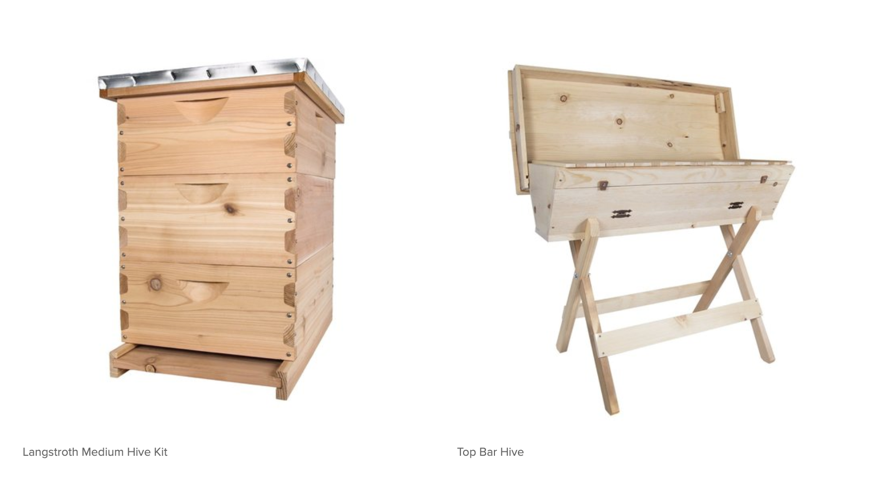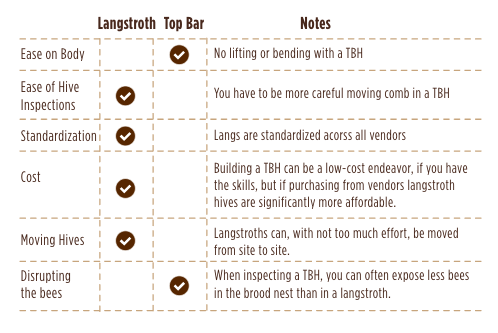This or That? Choosing Your Hive Type

One of the challenging aspects of starting a hobby as a beekeeper is you are required to make a number of important decisions when you know very little and have almost no, if any, beekeeping experience! One of those decisions is what type of hive you will keep. While there are several types of hives, the two most common in North America are the top bar hive and the Langstroth. I started on top bars, but moved to Langstroth in my second year of beekeeping. Langstroth hives are used by commercial beekeepers and most hobbyists, though top bars are becoming more popular. Beekeepers, both hobbyist and professional, tend to be very opinionated and strong willed about the ‘right’ way to keep bees, and like most things, I find that most folks tend to keep whatever type of hive they are first introduced to.
Either type of hive has proven to work just fine, but it’s important you find one that works best for you! I’ve broken down some of the considerations below, and I hope it will help you make this decision. Some of the terms I use below may be new to you, but don’t fret. For now, just understanding how these considerations apply to your situation and determining your priorities in a hive is most important!
DO YOU EVEN LIFT, BRO?
This is where the top bar really shines, due to the lack of lifting and stooping required to work your bees. Bees build from the front of the hive to the back, and you don’t have any way to add additional space, top bars require no heavy lifting. Further, the hive is at waist level, so you can work comfortably standing straight up. You should be able to life 40 pounds if you decide to go the way of the Langstroth. Keep in mind you won’t be lifting boxes that heavy year round, just during honey season! However, if lifting that amount even a few times a year will be challenging for you, consider choosing a top bar hive.
BOTTOM LINE: If lifting and bending is an issue, choose a top bar.
GOT MY MIND ON MY HONEY AND MY HONEY ON MY MIND.
Your bees can theoretically produce more honey in a Langstroth hive over a top bar, because you can add additional space for their honey stores. In a top bar hive, when the bees hit the back wall and still need more space, they will be looking to swarm (or you can decide to split.) But in a Langstroth, you can add additional boxes ahead of the honey flow, or decrease as necessary. Of course we have already established that you aren’t keeping bees with honey as primary motivation, so this a moot point, right!? 😉
BOTTOM LINE: Langstroths can arguably produce more honey, but there are so many other factors involved in honey production (many out of your control), that you should mark this off your considerations list.
MEETS THE STANDARD
Although it is now fairly simple to find a top bar hive manufacturer, not too many years ago if you wanted a top bar hive you had to build it yourself. However, because manufacturers are just now coming around to mass producing top bar hives, no industry standards exist for these hives. Whereas if you buy an 8 frame hive body from us, an 8 frame inner cover from another company, and an 8 frame bottom board from yet another producer, they will all fit together just fine! Once you select a top bar hive manufacturer, you may be ‘stuck’ with buying any additional top bars from that same company. Of course, if you decide to build your own top bar and are ok continuing to fabricate additional hives and parts, this point doesn’t matter. Almost all accessories are also meant to be paired with a Langstroth hive, though we don’t think most of these accessories are critical anyway.
TIP: If you go the route of the Langstroth, I strongly encourage you to use all medium hive bodies, rather than the ‘industry standard’ of starting with one or two deeps for your brood boxes and mediums for your honey supers. You’ll thank me when you reach for a frame and realize you don’t have to check twice to ensure you have the right size frame, because all of your supers take the same size!
BOTTOM LINE: If standardization of equipment is critical, go with a Langstroth, and choose medium hive bodies.
YOU BETTER WORK.
Top bars require a bit more maintenance, particularly early on. Personally, I can inspect a Langstroth hive much more quickly than I can a top bar, because I can manipulate and handle the frames quicker and I don’t have to be as concerned about breaking comb. On the other hand, the beauty of a top bar is if you just need to pull a few combs, you expose and ‘disturb’ a much smaller portion of the nest with each frame you pull. If you are planning to run a large number of hives, then perhaps the time needed to inspect should be considered, but if you are just running a few hives this probably isn’t a concern.
BOTTOM LINE: Langstroth require less work and time, but unless you are looking to become a sideliner professional beekeeper, this metric is negligible.
Enjoy the time you get with your bees, and don’t look at is as a job.
IF YOU’VE GOT THE MONEY, HONEY
This category is a sort of toss up. Top bar hives, when purchased from a third party, tend to be relatively more expensive. You can get a decent Langstroth hive for under few hundred bucks, whereas top bars can run you over $400. (Word to the wise: there are a number of cheap Langstroth hives on the market, but remember you get what you pay for. Look for hives made from materials that are longer lasting and that don’t require treatment or painting.) On the other hand, if you or someone you know is handy with a saw and nails, you can build your own top bar from reclaimed materials for pennies! Make sure you look for plans online, as proper spacing and size of your top bars is critical.

BOTTOM LINE: If affordability is your priority, choose a Langstroth made from long-lasting materials or build your own top bar from plans.
In closing, once you choose the hive type that works best for you, ensure you do your research and prepare for your new bees! For example, you’ll want to make sure either hive type you go with are on level ground. In another post found here, I’ll go more into depth on how you can prepare and select the best site for your hives.
Also, if you are searching for equipment, be sure to stop by our shop in Austin to take a look at what we’ve got in stock.
Equipment we’ve got in our shop can be found here!



When is your garage sale?
Thank you
Hi, Gina. The garage sale is Saturday, March 11th from 9a-2p.